Once my garden finally comes to life in the spring, it seems so utterly groggy for so many weeks, I finally feel like poking it with a big stick. More than once have I smashed shoots just emerging from the ground, milling about where I had no business. One foolishly warm day in March turns the old blood over, as Theodore Roethke would say, and I am out there searching for any sign of life. The next day is inevitably wintry. I am admirably able go on to my clients about the proper time for this or that, but frankly I am not any better at waiting than the next gardener. My landscape is a study in static the end of January. Every day is just about as dreary as the next. The sky I can see, which surely must be thousands of square miles, is the same sullen shade of bleak from edge to edge, and top to bottom. A relentlessly uniform tour de force, if you will. Michigan is known for for its astonishing number of sun-free winter days, should anyone be interested in that. How annoying -to be waiting for the weather to change.
Every walking surface is an icy and bumpy history of the footsteps of those few who venture out. The mail man has his signature bootprint. There are the corgi paws, the Fex Ex man, whose boots are distinctly different than the UPS man, and the meter reader prints. The arrival of the mail truck ranks as an event. Friends in the neighborhood honk the horn as they drive by; they are waiting for spring too. Still stubbornly wearing tennis shoes, I slide all over the terrain. Playing ball with the corgis in the drive is more about keeping my balance than watching them. They slide around, slip up and flip over- with gusto. They draw no distinction between a balmy spring day and today’s plate of frozen mush. Milo manages to find yet one more fresh deep patch of snow in which to bury his ball, and them triumphantly dives and retrieves it, as if he had never before had so much fun. He has better than an instinct to survive the waiting; he lives for that triumphant moment when can burst through the door, and be outdoors. Why can’t I do this? I man that door for him as if it were the starting gate at the Kentucky Derby. (Waiting does strange things to people.) I may wait 15 seconds before I fling the door open-he is spot on at full speed the moment I make my move. He is halfway down the drive, and already circling back to see if I am there; I assure you I am not through the door yet. We may do this a dozen times a day, or better.
The seed and nursery catalogues come in droves in January. They can furnish me with no small amount of diversion, entertainment, and serious interest, while I am waiting. I even study the descriptions of the vegetable seeds-though I grow none. Sorting through 500 tomato varieties, both heirloom and new, is better than a walk through my neighborhood. The packages are alluring, all the varieties worth pondering. I have been known to buy packets of seeds of plants I have no intention to grow. It’s enough to just look at them. A nursery on the West Coast grows espaliered lindens, and sells them large enough to plant free standing-how intriguing is this? The growers from Lake County in Ohio are many; the land there is rich and productive. Herman Losely and Sons, Bluestone Perennials, Lake County Nursery-they all grow great plants; reading their catalogues often inspires design ideas. Sunny Border Nursery-I could order a semi-truck load of rock plants and hens and chicks from them on a day like today. I have a stack of those catalogues measuring 23 inches tall. My stack of magazines, all relating to design in some way or another is probably 4 feet tall. I do not have the time to really read during the gardening season. Cote Sud, Cote Ouest, the English version of Country Living- I stack them up for the winter when I can concentrate, and cut out images I do not wish to part with. I do have a stash of magazine pages I go through on occasion, some dating back a long time. Sitting in the waiting room of the garden, all of these materials provide a little hope for the future. I winter-read, with the exception of Garden Illustrated; for this publication, I can’t wait. When it comes, I read.
I have a collection of antique seed catalogues, dating back to the turn of the century. Suttons Seeds from England, Marshall’s Seeds from New York City in 1927, Dreer’s from Philadelphia-I love the old ones. The engravings are beautiful, but more, I appreciate the earnest notes of those gardeners, caught in the stranglehold of January, favoring this variety or that. No matter where these catalogues came from, and no matter where I find them, gardeners are mumbling to themselves about what they will do once the starting gate swings open. These notes are invariably in pencil. Any note in pencil can easily be changed, updated, altered, or tuned up, right? Shall I buy one packet of 25 seeds, or are three packets, at a better price, what I really need? Wait-would this variety be better? Things are underlined; the margins are full of scribbles. Gardeners all over are writing about what seeds they will be growing, waiting for that time when they can stop writing and start growing. I would begrudgingly admit this time of year may be about waiting, but it should be about planning, and anticipation.
Wait one moment please-am I really thinking I am tired of again trying to find perennials that will mature properly short enough in front of my boxwood? Or should I move that boxwood two feet forward, and plant the taller plants of my dreams behind it? Whatever decision I make, there will be better than several winter months in which to consider that decision. No need for any ink yet. A garden is big work-this makes the planning all the more important. Taking one’s winter to plan is a sterling idea; it is even a better idea to take your eyes off the skies, and put them to use elsewhere. I would be the better for taking my own advice. Once I take the time to sort through what has been in my garden, I will be waiting for my big box of seeds, in beautifully rendered packages clearly marked 2010, to finally arrive.
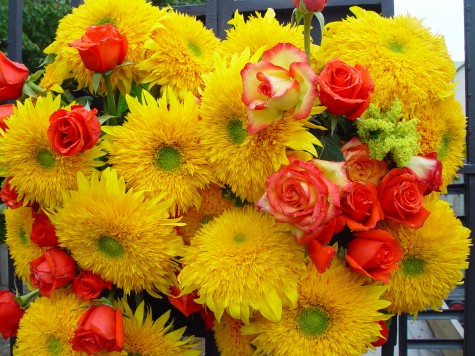


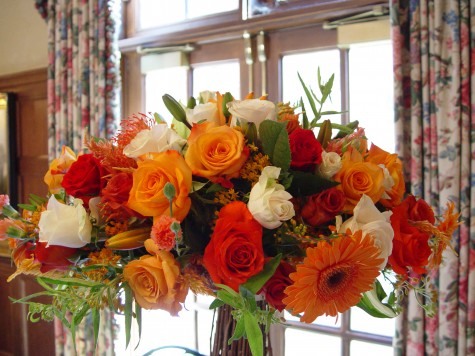
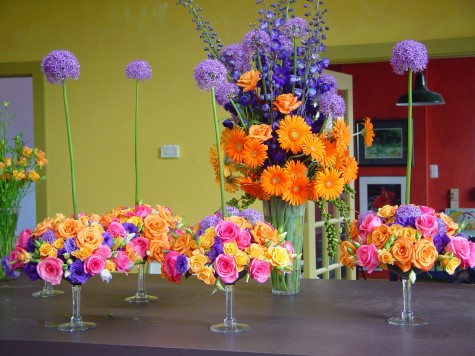

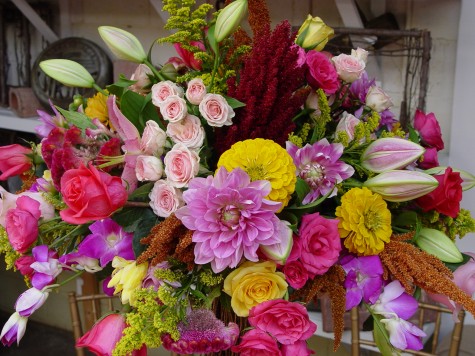
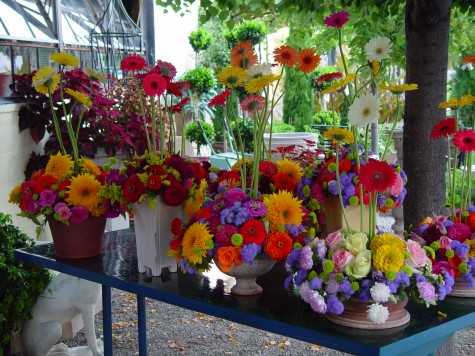
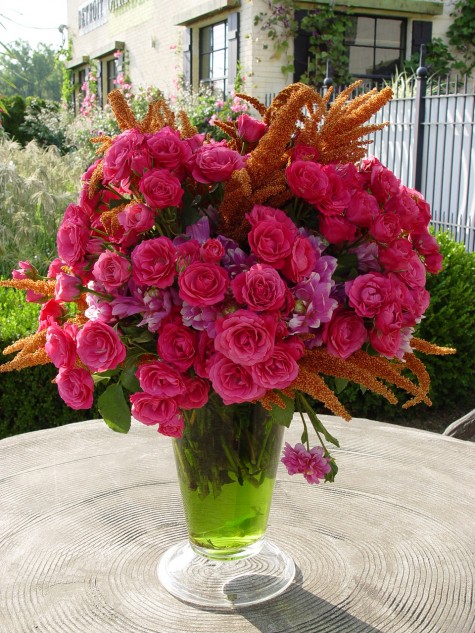
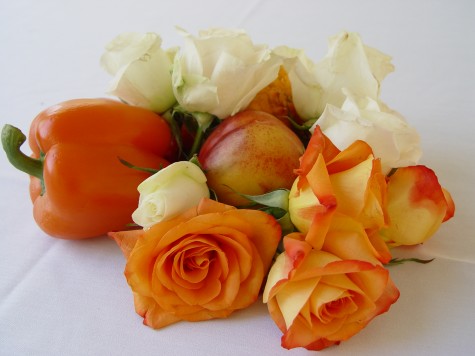
 There are plenty of ways to think about white. If you take red, blue and yellow light and mix them up in equal amounts, the result is white light. White snow or dense fog on a sunny day appears blindingly white, as they reflects all every color, and appear devoid of any color. Devoid of color is one way of talking about white. This snow looks gray, as it was photographed on a cloudly sullen day-no light making for white white. Scientific discussion about exactly what constitutes the nature of white-there are lots of theories. No designer needs to understand the physics or chemistry of white as much as they need to observe what white does in a composition.
There are plenty of ways to think about white. If you take red, blue and yellow light and mix them up in equal amounts, the result is white light. White snow or dense fog on a sunny day appears blindingly white, as they reflects all every color, and appear devoid of any color. Devoid of color is one way of talking about white. This snow looks gray, as it was photographed on a cloudly sullen day-no light making for white white. Scientific discussion about exactly what constitutes the nature of white-there are lots of theories. No designer needs to understand the physics or chemistry of white as much as they need to observe what white does in a composition. 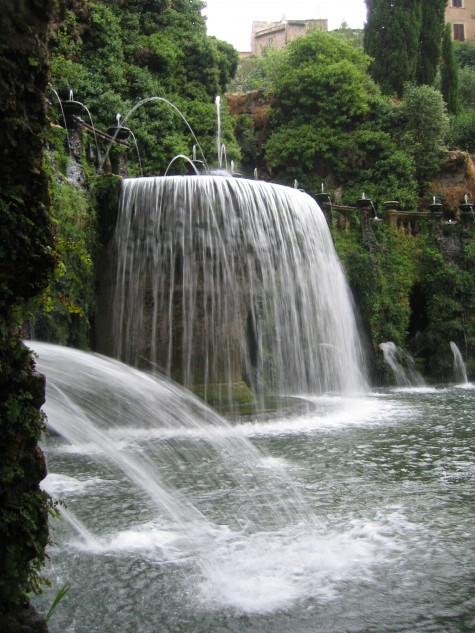 I never think about white without thinking about light. Water is transparent, or colorless, it transmits any color behind it. The water in the air from this Italian fountain is reflecting all the colors of the light spectrum. This clear water appears white- in bright light. “White water”, or churning airborne water, looks just like snow. If you squint at this picture, so all the individual details drop out, the white will seem close to your eye, and grab your attention. The green seems to recede, and hang back. A landscape is very much about the creation of a sense of depth. There are actual spaces, with dimensions you can measure. A physical space that is very shallow can visually appear to be quite spatial. How you use back and white, or light and dark, is key to this.
I never think about white without thinking about light. Water is transparent, or colorless, it transmits any color behind it. The water in the air from this Italian fountain is reflecting all the colors of the light spectrum. This clear water appears white- in bright light. “White water”, or churning airborne water, looks just like snow. If you squint at this picture, so all the individual details drop out, the white will seem close to your eye, and grab your attention. The green seems to recede, and hang back. A landscape is very much about the creation of a sense of depth. There are actual spaces, with dimensions you can measure. A physical space that is very shallow can visually appear to be quite spatial. How you use back and white, or light and dark, is key to this. 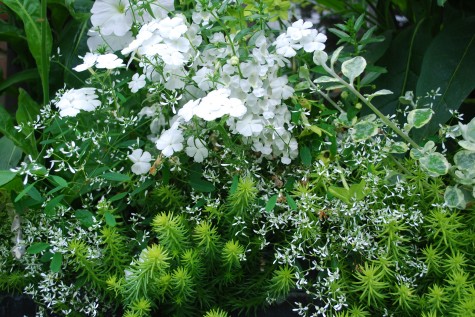 White has strong emotional connotations-as any color does. Imagine how you would feel arriving at a hospital for surgery where everyone was dressed in black? Or red? Or anything but white? White looks pure, fresh, crisp and clean. This white annual phlox brings all of the above to mind.
White has strong emotional connotations-as any color does. Imagine how you would feel arriving at a hospital for surgery where everyone was dressed in black? Or red? Or anything but white? White looks pure, fresh, crisp and clean. This white annual phlox brings all of the above to mind.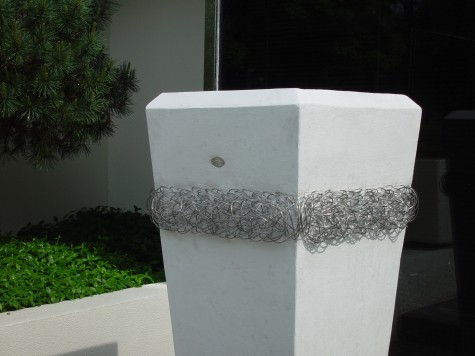 Pairing white with some sharply defined geometry can be clean and contemporary, and on the edge of glaring. My main objection to contemporary landscape design has to do with the lack of any attendant and contrasting softness. Mid century modern design does so well expressing a contemporary point of view, without being pitilessly stark. How this container gets planted will be key to its visual success.
Pairing white with some sharply defined geometry can be clean and contemporary, and on the edge of glaring. My main objection to contemporary landscape design has to do with the lack of any attendant and contrasting softness. Mid century modern design does so well expressing a contemporary point of view, without being pitilessly stark. How this container gets planted will be key to its visual success.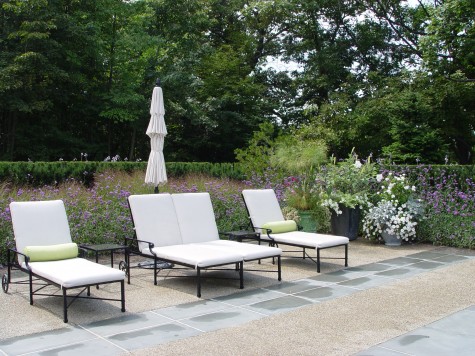 White furniture in the landscape is cool and inviting, not cold. This black and white furniture, set on a bluestone and concrete aggregate terrace draws the eye, and invites company to gather. The attendant landscape is softer and looser, without being messy or disorganized. The invitation to sit is the most important visual element here; the landscape follows up with the suggestion of soft enclosure. But the invitation issued in white reads first.
White furniture in the landscape is cool and inviting, not cold. This black and white furniture, set on a bluestone and concrete aggregate terrace draws the eye, and invites company to gather. The attendant landscape is softer and looser, without being messy or disorganized. The invitation to sit is the most important visual element here; the landscape follows up with the suggestion of soft enclosure. But the invitation issued in white reads first.  Many antique garden ornaments, whether stone, iron, or concrete, have been painted white. Perhaps the origin of this practice has to do with an effort to make those ornaments stand out. Vintage white paint on an object has a feeling that enchants those who love classical gardens, as well as those who love cottage gardens. In one of my lives, I would like a house with white limed floors, white walls, and white everywhere. How serene and beautiful this would be.
Many antique garden ornaments, whether stone, iron, or concrete, have been painted white. Perhaps the origin of this practice has to do with an effort to make those ornaments stand out. Vintage white paint on an object has a feeling that enchants those who love classical gardens, as well as those who love cottage gardens. In one of my lives, I would like a house with white limed floors, white walls, and white everywhere. How serene and beautiful this would be.  Though the only thing on my mind come spring is some color, I do love white tulips. These Maureen tulips, paired with the black blooming Queen of the Night tiulip, is a different sort of spring display; stately and formal, I would say. Though white flowers attract visual attention from afar, and can light an evening garden, I like what white does to direct your attention to the form. A white tulip will permit you to see more about the shape of a tulip than any other color. Color can be a distraction. Sometimes if ideas seem scarce when I am designing a landscape, I print all my study photos in black and white.
Though the only thing on my mind come spring is some color, I do love white tulips. These Maureen tulips, paired with the black blooming Queen of the Night tiulip, is a different sort of spring display; stately and formal, I would say. Though white flowers attract visual attention from afar, and can light an evening garden, I like what white does to direct your attention to the form. A white tulip will permit you to see more about the shape of a tulip than any other color. Color can be a distraction. Sometimes if ideas seem scarce when I am designing a landscape, I print all my study photos in black and white. 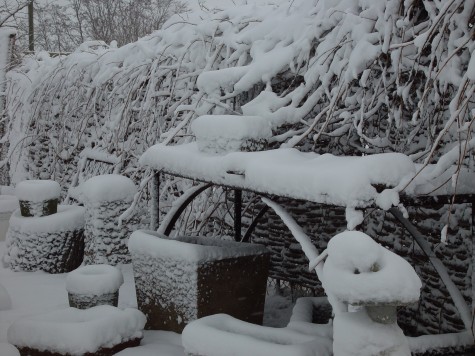 My life is all about the white now. Far from being a stock color, the character of white is so influenced by whatever light I might have delivered to my door in the morning. I especially appreciate how it defines, and then blurs the shapes of everything outdoors. I like how it makes me see big forms and shapes in clean relief. This makes me understand how a gardener could be very keen for a white garden.
My life is all about the white now. Far from being a stock color, the character of white is so influenced by whatever light I might have delivered to my door in the morning. I especially appreciate how it defines, and then blurs the shapes of everything outdoors. I like how it makes me see big forms and shapes in clean relief. This makes me understand how a gardener could be very keen for a white garden. 
 Any person who has ever had a mind to cultivate a garden has a love for all of nature’s creatures. Even the aphids I squish, and the Japanese beetles I whisk into bags for the trash, the rabbits, the white flies on my dahlias that enrage me, the bloody slugs-I still have a tough time not welcoming any of nature’s creatures to my garden. I might as well put up a sign: Any natural transient welcome: room and board available at no charge and please, stay as long as you like. No wonder that sculptures of bugs, birds, dogs, are every bit as interesting to gardeners as sculptures of the human sort.
Any person who has ever had a mind to cultivate a garden has a love for all of nature’s creatures. Even the aphids I squish, and the Japanese beetles I whisk into bags for the trash, the rabbits, the white flies on my dahlias that enrage me, the bloody slugs-I still have a tough time not welcoming any of nature’s creatures to my garden. I might as well put up a sign: Any natural transient welcome: room and board available at no charge and please, stay as long as you like. No wonder that sculptures of bugs, birds, dogs, are every bit as interesting to gardeners as sculptures of the human sort. 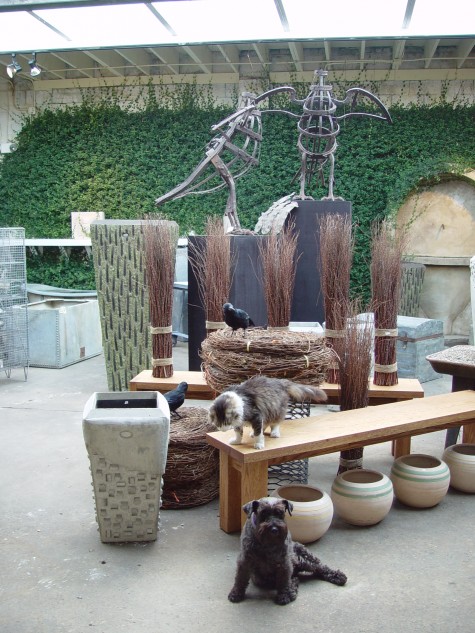 Gardeners understand that people don’t own the planet, they are but one species among a whole planet of species. My shop has always been friendly to all manner of fauna. The corgis have been here every day for the last four years, and MCat maybe 7 years; these three came during the reign of Hoppy the toad, Jojo the cat and Jack and Libby, the mini schnauzers. Who knows who or how another creature might be added to the current Corgi administration; anything can change. The place would not seem right without them; many people know them by name, bring treats, or pitch the ball down the driveway for them. These astonishing cast and wrought iron armatures are all that remain of a pair of eagle sculptures from France, some several hundred years old. Though made of iron, they have an unmistakeable air of power and vitality. The little faux crows-we like these too.
Gardeners understand that people don’t own the planet, they are but one species among a whole planet of species. My shop has always been friendly to all manner of fauna. The corgis have been here every day for the last four years, and MCat maybe 7 years; these three came during the reign of Hoppy the toad, Jojo the cat and Jack and Libby, the mini schnauzers. Who knows who or how another creature might be added to the current Corgi administration; anything can change. The place would not seem right without them; many people know them by name, bring treats, or pitch the ball down the driveway for them. These astonishing cast and wrought iron armatures are all that remain of a pair of eagle sculptures from France, some several hundred years old. Though made of iron, they have an unmistakeable air of power and vitality. The little faux crows-we like these too.  Troy’s sculptures of birds and animals speak much to his respect and love of nature. His work has great appeal, for good reason. I so love how directly he sculpts. Some garden sculpture is more about the technique of the sculptor, rather than the feeling of the sculpture itself. People readily sort this out, and gravitate towards that which strikes a chord for them. Whether it be for fun, or in memory of something or someone, an appreciation for art in a garden comes naturally.
Troy’s sculptures of birds and animals speak much to his respect and love of nature. His work has great appeal, for good reason. I so love how directly he sculpts. Some garden sculpture is more about the technique of the sculptor, rather than the feeling of the sculpture itself. People readily sort this out, and gravitate towards that which strikes a chord for them. Whether it be for fun, or in memory of something or someone, an appreciation for art in a garden comes naturally. 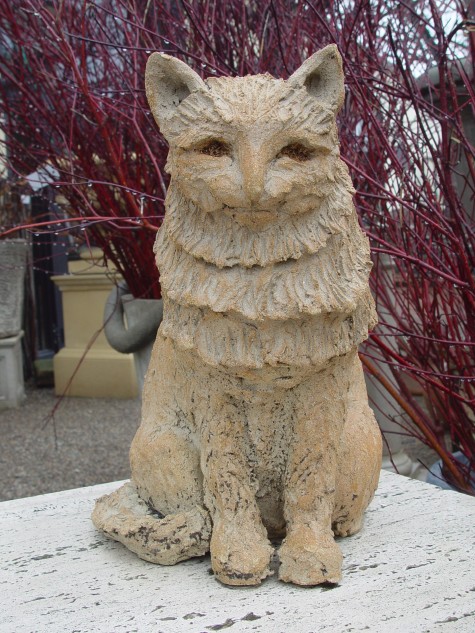 Mary Hode is an English sculptor of formidable talent. Her husband fashions garden pots I treasure. But her stoneware sculptures of cats are so beautiful, I would be confident asking any person to consider adding her work to their collection-whether for inside or out. Their faces have a distinctly human look about them; I understand this. I do believe my Corgis are people in dog costumes.
Mary Hode is an English sculptor of formidable talent. Her husband fashions garden pots I treasure. But her stoneware sculptures of cats are so beautiful, I would be confident asking any person to consider adding her work to their collection-whether for inside or out. Their faces have a distinctly human look about them; I understand this. I do believe my Corgis are people in dog costumes. 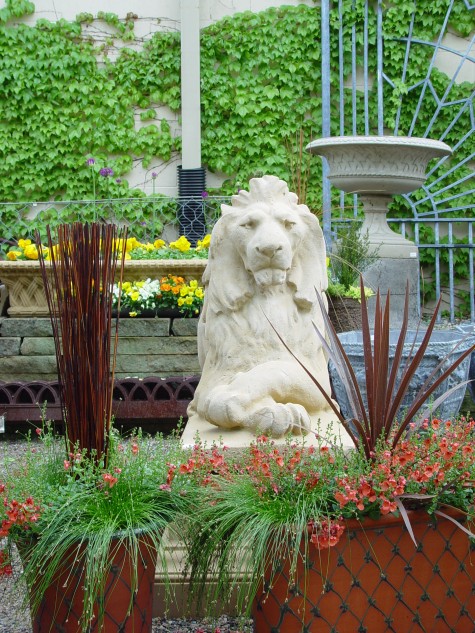 No lion lives in my zone, but the lion is a very popular motif in garden sculpture. They are on duty every day, holding court, standing watch. This English cast stone lion has a very British culture feeling to it.
No lion lives in my zone, but the lion is a very popular motif in garden sculpture. They are on duty every day, holding court, standing watch. This English cast stone lion has a very British culture feeling to it. 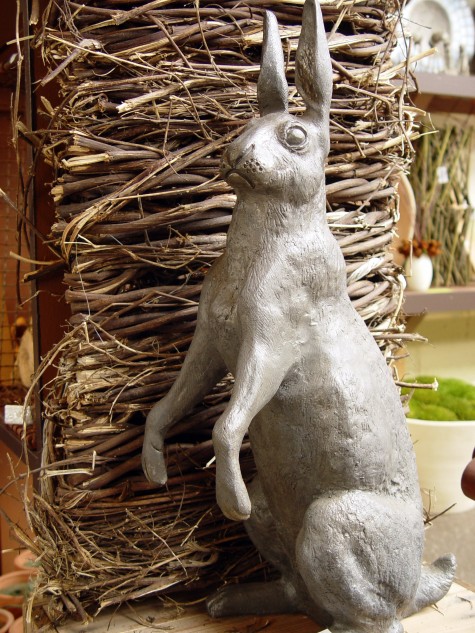 This finely detailed lead hare comes from the English lead ornament company known as Crowther and Sons. What gardener in my zone has not shared their garden with the rabbits? I do love the expression-you think he ate the lilies??
This finely detailed lead hare comes from the English lead ornament company known as Crowther and Sons. What gardener in my zone has not shared their garden with the rabbits? I do love the expression-you think he ate the lilies??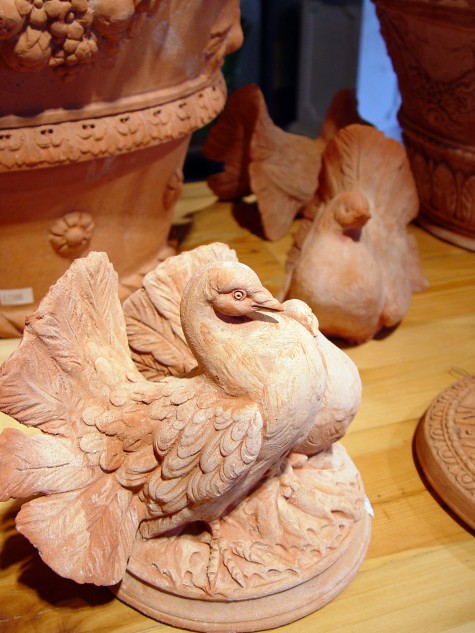 This handmade Italian terra cotta sculpture of a dove is beautifully rendered. I like small terra cotta sculptures like this, keeping my pots company over the summer. I have spots for them indoors, for the winter.
This handmade Italian terra cotta sculpture of a dove is beautifully rendered. I like small terra cotta sculptures like this, keeping my pots company over the summer. I have spots for them indoors, for the winter.  This Belgian concrete terrier circa 1930 has a sassy terrier expression, indeed. I gave him a rope collar for the winter. I never had much interest in the doll thing, but I do like dressing my sculpture for an occasion. Just for fun.
This Belgian concrete terrier circa 1930 has a sassy terrier expression, indeed. I gave him a rope collar for the winter. I never had much interest in the doll thing, but I do like dressing my sculpture for an occasion. Just for fun. 